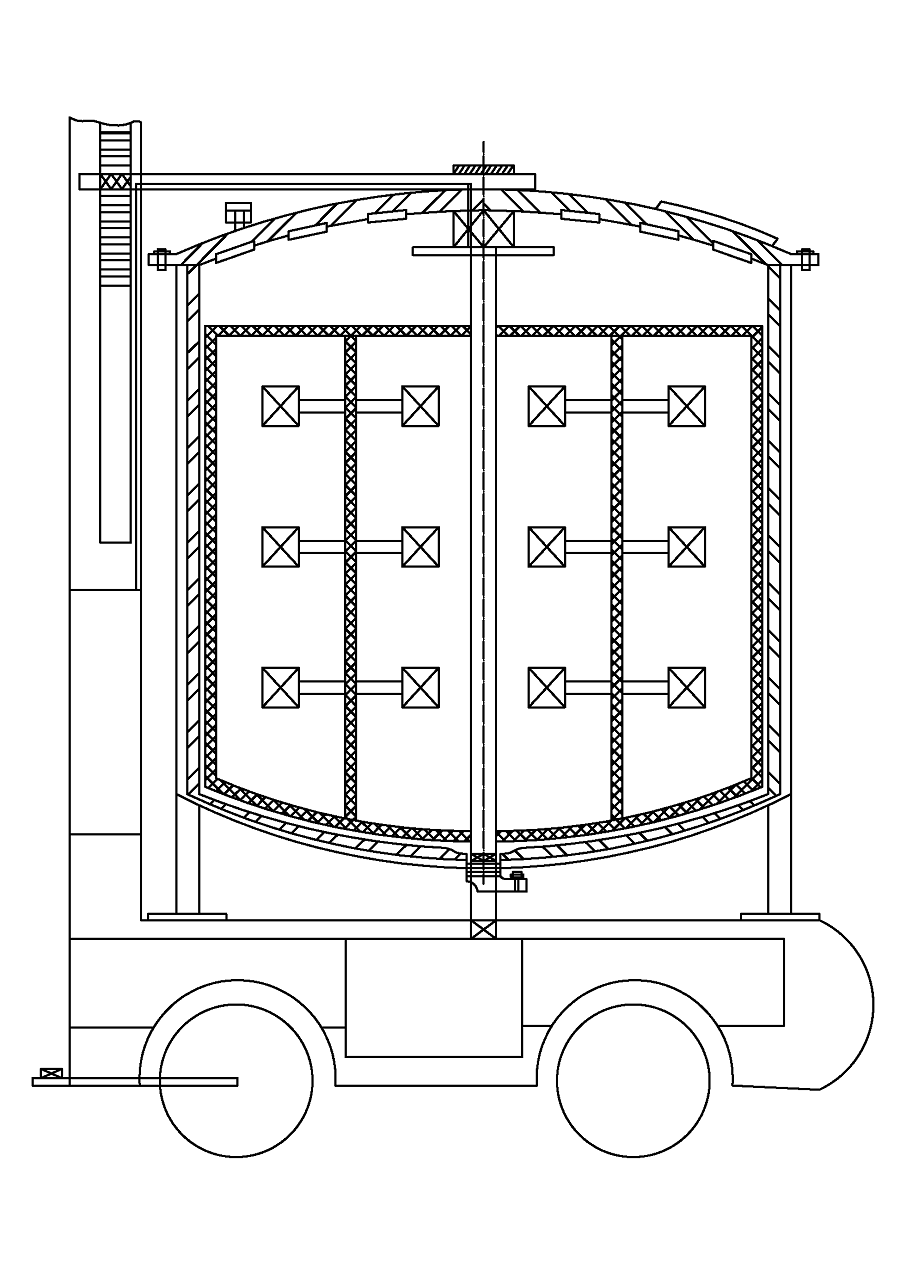Удосконалення реактора для згущення органічних рослинних полікомпонентних напівфабрикатів високого ступеня готовності
DOI:
https://doi.org/10.15587/1729-4061.2023.294119Ключові слова:
реактор для згущення, перемішуючий механізм, збільшення поверхня теплообміну, полікомпонентністьАнотація
Об’єктом дослідження є процес згущення органічних полікомпонентних композицій на основі топінамбура, яблука, гарбуза, журавлині та кизилу для отримання напівфабрикату високого ступеня готовності в умовах запропонованих апаратурно-технологічних рішень реалізованих в уніфікованому реакторі. Традиційні апарати для згущення мають парову систему теплопідведення, що призводить до перегрівання певних шарів сировини та запобігає формуванню мобільних властивостей апарата в умовах значної страти органічних властивостей сировини. Впровадження апратурно-технологічних рішень забезпечить конкурентноспроможні переваги реакторів за рахунок обігрівання плівкоподібним резистивним електронагрівачем випромінювального типу з використанням перемішуючого пристрою з обігріваємою поверхнею. Збільшуючи загальну площу теплообміну до 1,24 м2 (прототип – 0,98 м2). Забезпечується зменшення: питомих витрат теплоти на 20 %, питомої металоємність на 47 % та тривалості процесу на 30 %. Визначені реологічні властивості при згущенні органічної полікомпонентної композиції пасти за температури 55 °C та швидкості зсуву в межах 3,0…4,5 с-1, ефективна в’язкість знаходиться в інтервалі 22...3,5 Па·с. При цьому кінетика уварювання в удосконаленому реакторі на 27 % менша базової конструкції Р-П-150м. За органолептичними показниками композиція «Б» має приємний гармонійний смак всіх компонентів. Отримані результати досліджень актуальні для практичної реалізації про дотримуванні температурного діапазону в межах від 35 °C до 55 °C. Апаратурно-технологічні рішення формують конкурентоспроможність мобільних реакторів для згущення рослинних напівфабрикатів за умов ліквідації парової складової та збільшення поверхні теплообміну перемішуючого пристрою. Забезпечуючи перевагу в операційній тривалості з одночасним використанням елементів Пельтьє для перетворення вторинної теплоти на автономну роботу витяжних вентиляторів у моторному відсіку
Посилання
- Misra, N. N., Koubaa, M., Roohinejad, S., Juliano, P., Alpas, H., Inácio, R. S. et al. (2017). Landmarks in the historical development of twenty first century food processing technologies. Food Research International, 97, 318–339. doi: https://doi.org/10.1016/j.foodres.2017.05.001
- Chen, X., Gao, Z., McFadden, B. R. (2020). Reveal Preference Reversal in Consumer Preference for Sustainable Food Products. Food Quality and Preference, 79, 103754. doi: https://doi.org/10.1016/j.foodqual.2019.103754
- Cherevko, O., Mykhaylov, V., Zagorulko, A., Zahorulko, A. (2018). Improvement of a rotor film device for the production of highquality multicomponent natural pastes. Eastern-European Journal of Enterprise Technologies, 2 (11 (92)), 11–17. doi: https://doi.org/10.15587/1729-4061.2018.126400
- Boesveldt, S., Bobowski, N., McCrickerd, K., Maître, I., Sulmont-Rossé, C., Forde, C. G. (2018). The changing role of the senses in food choice and food intake across the lifespan. Food Quality and Preference, 68, 80–89. doi: https://doi.org/10.1016/j.foodqual.2018.02.004
- O’Shea, N., Ktenioudaki, A., Smyth, T. P., McLoughlin, P., Doran, L., Auty, M. A. E. et al. (2015). Physicochemical assessment of two fruit by-products as functional ingredients: Apple and orange pomace. Journal of Food Engineering, 153, 89–95. doi: https://doi.org/10.1016/j.jfoodeng.2014.12.014
- Habanova, M., Saraiva, J. A., Holovicova, M., Moreira, S. A., Fidalgo, L. G., Haban, M. et al. (2019). Effect of berries/apple mixed juice consumption on the positive modulation of human lipid profile. Journal of Functional Foods, 60, 103417. doi: https://doi.org/10.1016/j.jff.2019.103417
- Pylypenko, O. (2017). Development of Ukrainian food industry. Scientific Works of NUFT, 23 (3), 15–25. Available at: http://nbuv.gov.ua/UJRN/Npnukht_2017_23_3_4
- Marco, S.-C., Adrien, S., Isabelle, M., Manuel, V.-O., Dominique, P. (2019). Flash Vacuum-Expansion Process: Effect on the Sensory, Color and Texture Attributes of Avocado (Persea americana) Puree. Plant Foods for Human Nutrition, 74 (3), 370–375. doi: https://doi.org/10.1007/s11130-019-00749-3
- Zahorulko, A., Zagorulko, A., Yancheva, M., Dromenko, O., Sashnova, M., Petrova, K. et al. (2020). Improvement of the continuous "pipe in pipe" pasteurization unit. Eastern-European Journal of Enterprise Technologies, 4 (11 (106), 70–75. doi: https://doi.org/10.15587/1729-4061.2020.208990
- Borchani, M., Masmoudi, M., Ben Amira, A., Abbès, F., Yaich, H., Besbes, S. et al. (2019). Effect of enzymatic treatment and concentration method on chemical, rheological, microstructure and thermal properties of prickly pear syrup. LWT, 113, 108314. doi: https://doi.org/10.1016/j.lwt.2019.108314
- Zahorulko, A., Zagorulko, A., Cherevko, O., Dromenko, O., Solomon, A., Yakobchuk, R. et al. (2021). Determination of the heat transfer coefficient of a rotary film evaporator with a heating film-forming element. Eastern-European Journal of Enterprise Technologies, 6 (8 (114)), 41–47. doi: https://doi.org/10.15587/1729-4061.2021.247283
- Dolores Alvarez, M., Canet, W. (2013). Time-independent and time-dependent rheological characterization of vegetable-based infant purees. Journal of Food Engineering, 114 (4), 449–464. doi: https://doi.org/10.1016/j.jfoodeng.2012.08.034
- Vicente, A. R., Manganaris, G. A., Darre, M., Ortiz, C. M., Sozzi, G. O., Crisosto, C. H. (2022). Compositional determinants of fruit and vegetable quality and nutritional value. Postharvest Handling, 565–619. doi: https://doi.org/10.1016/b978-0-12-822845-6.00019-1
- Ding, Z., Qin, F. G. F., Yuan, J., Huang, S., Jiang, R., Shao, Y. (2019). Concentration of apple juice with an intelligent freeze concentrator. Journal of Food Engineering, 256, 61–72. doi: https://doi.org/10.1016/j.jfoodeng.2019.03.018
- Hobold, G. M., da Silva, A. K. (2019). Visualization-based nucleate boiling heat flux quantification using machine learning. International Journal of Heat and Mass Transfer, 134, 511–520. doi: https://doi.org/10.1016/j.ijheatmasstransfer.2018.12.170
- Solomon, A., Bondar, M., Dyakonova, A. (2019). Substantiation of the technology for fermented sour-milk desserts with bifidogenic properties. Eastern-European Journal of Enterprise Technologies, 1 (11 (97)), 6–16. doi: https://doi.org/10.15587/1729-4061.2019.155278
- Zahorulko, A. M., Zahorulko, O. Ye. (2016). Pat. No. 108041 UA. Hnuchkyi plivkovyi rezystyvnyi elektronahrivach vyprominiuiuchoho typu. No. u201600827; declareted: 02.02.2016; published: 24.06.2016, Bul. No. 12. Available at: https://repo.btu.kharkov.ua/handle/123456789/15246
- R-P-150m (MZ-2S-316) - Reaktor vakuum vyparnoy. Available at: https://www.oborud.info/product/jump.php?6109&c=619
- Cherevko, A., Mayak, O., Kostenko, S., Sardarov, A. (2019). Experimental and simulation modeling of the heat exchanche process while boiling vegetable juice. Progressive technique and technologies of food production enterprises, catering business and trade, 1 (29), 75–85. doi: https://doi.org/10.5281/zenodo.3263532
- Zahorulko, A., Zagorulko, A., Fedak, N., Sabadash, S., Kazakov, D., Kolodnenko, V. (2019). Improving a vacuum-evaporator with enlarged heat exchange surface for making fruit and vegetable semi-finished products. Eastern-European Journal of Enterprise Technologies, 6 (11 (102)), 6–13. doi: https://doi.org/10.15587/1729-4061.2019.178764

##submission.downloads##
Опубліковано
Як цитувати
Номер
Розділ
Ліцензія
Авторське право (c) 2023 Andrii Zahorulko, Aleksey Zagorulko, Lyudmila Chuiko, Alla Solomon, Larysa Sushko, Yuliia Tesliuk, Lesia Kriuchko, Anastasiia Dunaienko, Serhii Andrukh, Nataliia Tytarenko

Ця робота ліцензується відповідно до Creative Commons Attribution 4.0 International License.
Закріплення та умови передачі авторських прав (ідентифікація авторства) здійснюється у Ліцензійному договорі. Зокрема, автори залишають за собою право на авторство свого рукопису та передають журналу право першої публікації цієї роботи на умовах ліцензії Creative Commons CC BY. При цьому вони мають право укладати самостійно додаткові угоди, що стосуються неексклюзивного поширення роботи у тому вигляді, в якому вона була опублікована цим журналом, але за умови збереження посилання на першу публікацію статті в цьому журналі.
Ліцензійний договір – це документ, в якому автор гарантує, що володіє усіма авторськими правами на твір (рукопис, статтю, тощо).
Автори, підписуючи Ліцензійний договір з ПП «ТЕХНОЛОГІЧНИЙ ЦЕНТР», мають усі права на подальше використання свого твору за умови посилання на наше видання, в якому твір опублікований. Відповідно до умов Ліцензійного договору, Видавець ПП «ТЕХНОЛОГІЧНИЙ ЦЕНТР» не забирає ваші авторські права та отримує від авторів дозвіл на використання та розповсюдження публікації через світові наукові ресурси (власні електронні ресурси, наукометричні бази даних, репозитарії, бібліотеки тощо).
За відсутності підписаного Ліцензійного договору або за відсутністю вказаних в цьому договорі ідентифікаторів, що дають змогу ідентифікувати особу автора, редакція не має права працювати з рукописом.
Важливо пам’ятати, що існує і інший тип угоди між авторами та видавцями – коли авторські права передаються від авторів до видавця. В такому разі автори втрачають права власності на свій твір та не можуть його використовувати в будь-який спосіб.










